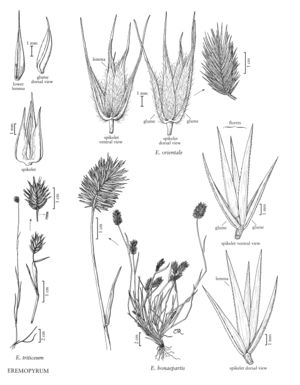Eremopyrum bonaepartis
Culms to 30 cm, smooth, mostly glabrous, puberulent below the spikes. Blades 3-5 mm wide, scabrous distally. Spikes 1.4-4.5 cm long, 1.3-2.8 cm wide, oblong, obtuse, or truncate; disarticulation at the rachis nodes. Spikelets 10-25 mm, with 3-5 florets. Glumes 4-19 mm, scabrous or hairy, 3-5-veined, 1-keeled, lateral veins obscure, bases straight; lemmas 6-24 mm, glabrous, scabrous, or hirsute, all alike in their pubescence, apices subacute to shortly awned; palea keels prolonged into 2 toothlike appendages. 2n = 14, 28.
Discussion
In the Flora region, Eremopyrum bonaepartis is known only from a few collections in Arizona. Several infraspecific taxa have been recognized in Eurasia: subsp. bonaepartis has glabrous lemmas and glumes; specimens with pilose, hirsute, or fairly scabrous lemmas and glumes have been referred to as subsp. hirsutum (Bertol.) Melderis or subsp. sublanuginosum (Drobow) Á. Löve ; and those with awned lemmas have been called subsp. turkestanicum (Gand.) Tzvelev. No attempt has been made to determine which are present in the Flora region.
Selected References
None.
